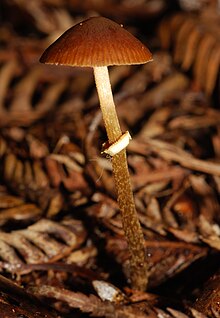Conocybe rugosa
| Conocybe rugosa | |
|---|---|

| |
| Scientific classification | |
| Domain: | Eukaryota |
| Kingdom: | Fungi |
| Division: | Basidiomycota |
| Class: | Agaricomycetes |
| Order: | Agaricales |
| Family: | Bolbitiaceae |
| Genus: | Conocybe |
| Species: | C. rugosa
|
| Binomial name | |
| Conocybe rugosa | |
| Synonyms[1] | |
| |
| Conocybe rugosa | |
|---|---|
| Gills on hymenium | |
| Cap is conical or flat | |
| Hymenium is adnexed | |
| Stipe has a ring | |
| Spore print is brown to reddish-brown | |
| Ecology is saprotrophic | |
| Edibility is deadly | |
Conocybe rugosa is a common species of mushroom that is widely distributed and especially common in the Pacific Northwest of the United States. It grows in woodchips, flowerbeds and compost.[2][3] It has been found in Europe, Asia and North America.[2][3] It contains the same mycotoxins as the death cap mushroom. Conocybe rugosa was originally described in the genus Pholiotina, and its morphology and a 2013 molecular phylogenetics study supported its continued classification there.[4]
Description
[edit]Conocybe rugosa has a conical cap that expands to flat, usually with an umbo. It is less than 3 cm across, has a smooth brown top, and the margin is often striate. The gills are rusty brown, close, and adnexed. The stalk is 2 mm thick and 1 to 6 cm long, smooth, and brown, with a prominent and movable ring. The spores are rusty brown, and it may be difficult to identify the species without a microscope.[5]
Toxicity
[edit]This species is deadly poisonous.[6] They produce alpha-amanitin, a cyclic peptide that is highly toxic to the liver and is responsible for many deaths by poisoning from mushrooms in the genera Amanita and Lepiota. They are sometimes mistaken for species of the genus Psilocybe due to their similar looking cap.
See also
[edit]References
[edit]- ^ "GSD Species Synonymy Conocybe rugosa (Peck) Watling (1981)". Species Fungorum. Kew Mycology (2015). Retrieved 2024-02-28.
- ^ a b Hausknecht A, Krisai-Greilhuber I, Voglmayr H (2004). "Type studies in North American species of Bolbitiaceae belonging to the genera Conocybe and Pholiotina". Österreichische Zeitschrift für Pilzkunde. 13: 153–235.
- ^ a b Hausknecht, Anton; Kalamees, Kuulo; Knudsen, Henning; Mukhin, Viktor (2009). "The genera Conocybe and Pholiotina (Agaricomycotina, Bolbitiaceae) in temperate Asia" (PDF). Folia Cryptogamica Estonica. 1345: 23–47.
- ^ Tóth, Annamária; Hausknecht, Anton; Krisai-Greilhuber, Irmgard; Papp, Tamás; Vágvölgyi, Csaba Vágvölgyi; Nagy, László G. (2013). "Iteratively Refined Guide Trees Help Improving Alignment and Phylogenetic Inference in the Mushroom Family Bolbitiaceae". PLOS ONE. 8 (2): e56143. Bibcode:2013PLoSO...856143T. doi:10.1371/journal.pone.0056143. PMC 3572013. PMID 23418526.
- ^ Trudell, Steve; Ammirati, Joe (2009). Mushrooms of the Pacific Northwest. Timber Press Field Guides. Portland, OR: Timber Press. pp. 179–180. ISBN 978-0-88192-935-5.
- ^ Phillips, Roger (2010). Mushrooms and Other Fungi of North America. Buffalo, NY: Firefly Books. p. 214. ISBN 978-1-55407-651-2.
